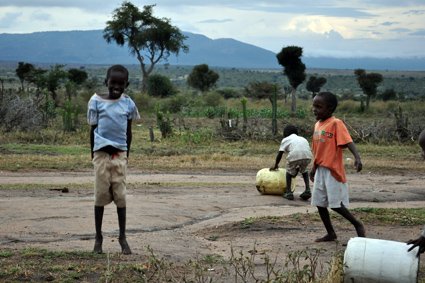- Share this article
- Subscribe to our newsletter
2018 – less money for development aid
Foreign aid from official donors in 2018 fell 2.7 per cent from 2017. The decline was particularly strong for the neediest countries, according to preliminary data collected by the OECD. The drop was largely due to less aid being spent on hosting refugees as arrivals slowed and rules were tightened on which refugee costs can come out of official aid budgets.
Official development assistance (ODA) from the 30 members of the OECD’s Development Assistance Committee (DAC) totalled 153.0 billion US dollars (USD) in 2018. In calculating, a new “grant-equivalent” methodology was used that takes loans into account. Under the “cash-flow basis” methodology used in the past, 2018 ODA was USD 149.3 billion, down 2.7 per cent in real terms from 2017. Excluding aid spent on processing and hosting refugees, ODA was stable from 2017 to 2018.
Least developed countries and Africa especially hard hit
Using the cash-flow basis ODA figure to compare 2018 with 2017 shows that bilateral ODA to the least-developed countries fell by three per cent in real terms from 2017, aid to Africa fell by four per cent, and humanitarian aid fell by eight per cent. ODA outflows in 2018 rose in 17 donor countries, with the biggest increases in Hungary, Iceland and New Zealand. ODA outflows fell in twelve countries, due in some to fewer refugee arrivals, with the largest declines in Austria, Finland, Greece, Italy, Japan and Portugal. According to OECD Secretary-General Angel Gurría, this trend was particularly worrying as it followed data showing that private development flows were also declining. Donor countries were not living up to their 2015 pledge to ramp up development finance, making it more difficult to achieve the 2030 Sustainable Development Goals.
Only five out of 30 countries on track
As the calculations demonstrate, the grant-equivalent ODA figure for 2018 is equivalent to 0.31 per cent of the DAC donors’ combined gross national income (GNI), well below the target ratio of 0.7 per cent ODA to GNI. Five DAC members – Denmark, Luxembourg, Norway, Sweden and the United Kingdom – met or exceeded the 0.7 per cent target. Non-DAC donors Turkey and the United Arab Emirates, whose ODA is not counted in the DAC total, provided 1.10 per cent and 0.95 per cent respectively of their GNI in development aid.
New system to create more transparency
According to DAC Chair Susanna Moorehead, the new grant-equivalent methodology which the DAC agreed in 2014 is a more accurate and transparent way of measuring donor effort. It should provide a more realistic comparison between grants, which made up 83 per cent of bilateral ODA in 2018, and loans, which were at 17 per cent.
It was also designed to incentivise donors to send the most concessional loans, and more grants, to the countries that need them most.
(OECD/sri)
More information:
Visit OECD website





Add a comment
Be the First to Comment